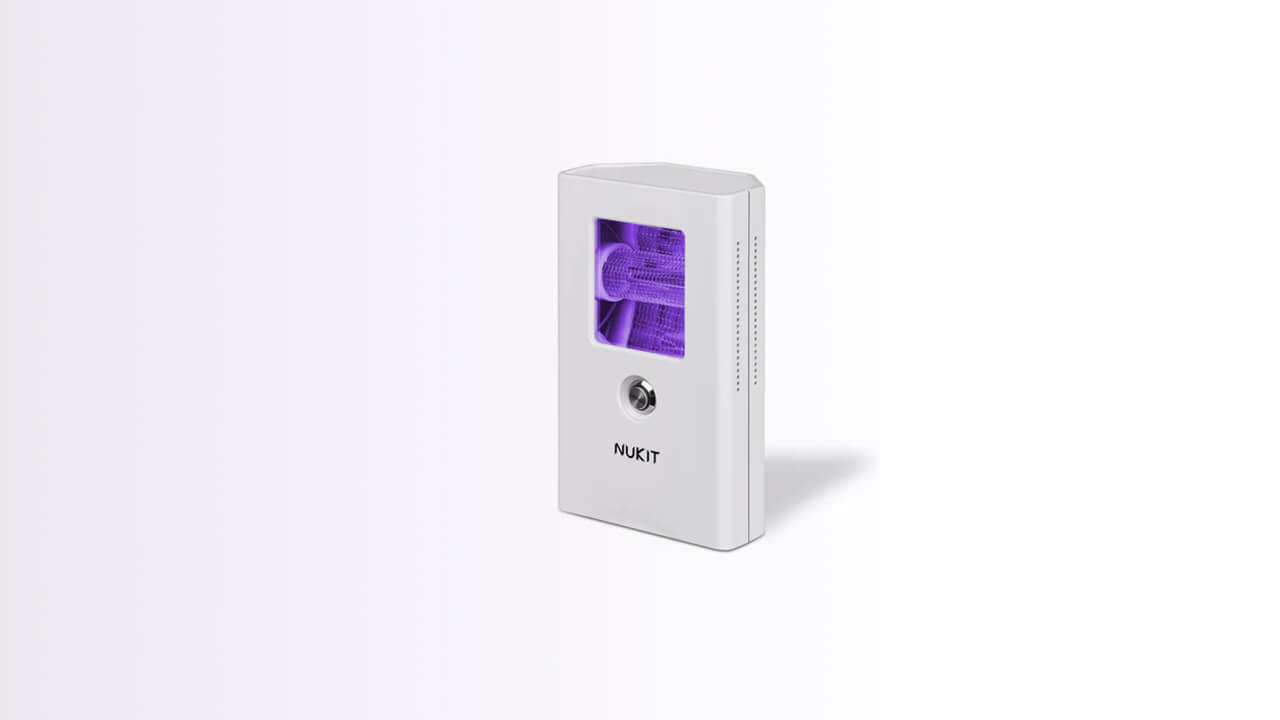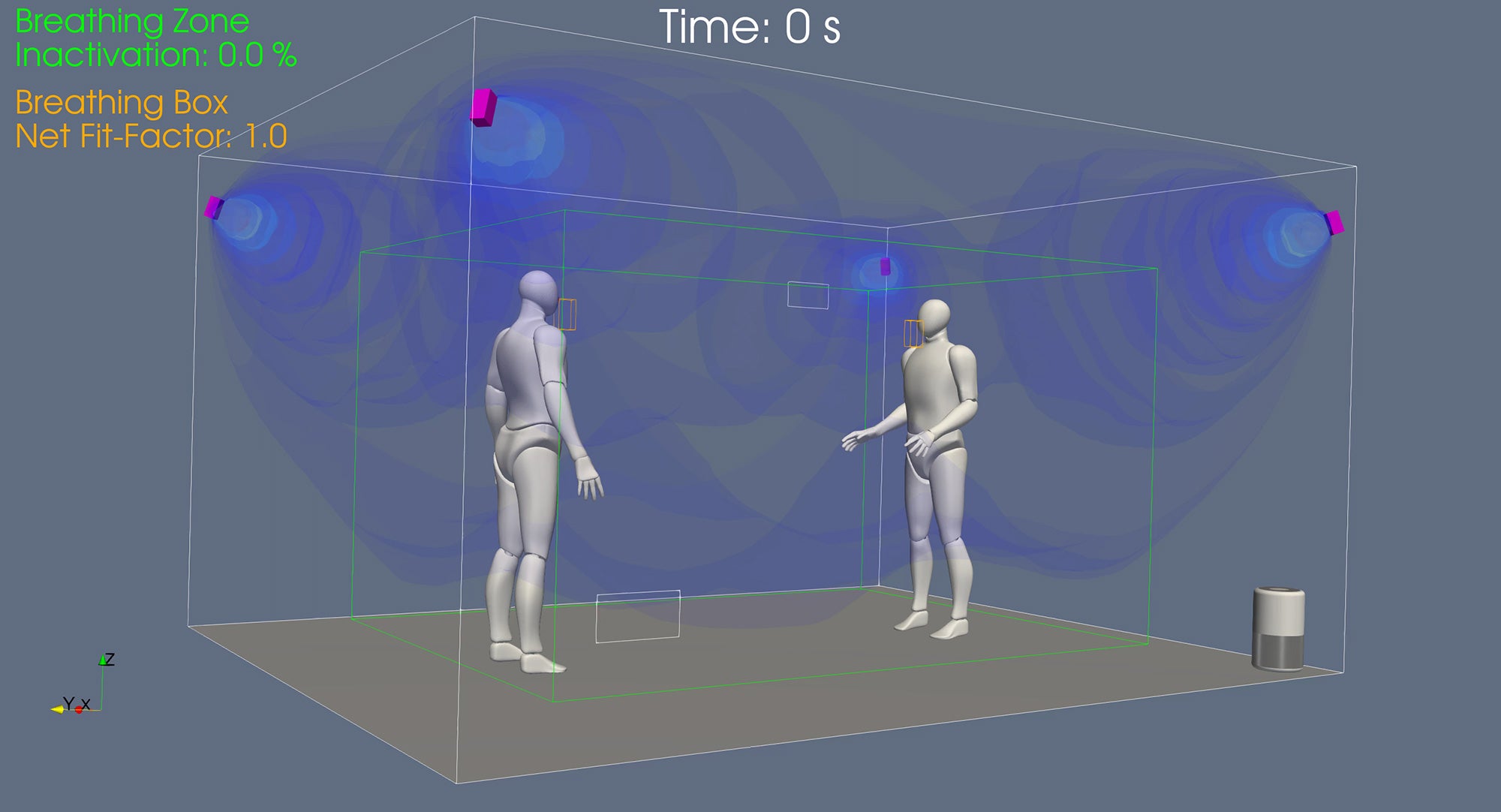Your safety matters
Third-party testing and research have proven that even high doses of 222nm Far-UVC are harmless to skin and eyes.

Skin Safety
"222nm wavelength Far-UVC light cannot penetrate
the outer dead-cell layer of the skin."

Eye Safety
“222nm wavelength Far-UVC light cannot reach
nor penetrate the ocular tear layer of the eye.”
Inter-institutional trials were conducted across the world, locations include:
- Columbia University Center for Radiological Research New York, USA
- Columbia University Irving Medical Center New York, USA
- Shimane University Faculty of Medicine, Japan
- St Andrews University, Scotland
- University of Dundee, Scotland
- Tongji Medical College, China
- Huazhong University of Science and Technology, China
- Leeds University, England
- Brazilian Biosciences National Laboratory, Brazil
- Brazilian Center for Research in Energy and Materials, Brazil
- Brazilian Synchrotron Light Laboratory, Brazil
- Sao Carlos Institute of Physics, Brazil
Research scientists who ran the tests and trials include:
- Dr Ewan Eadie – MSci, PhD, CSci, MIPEM
Head of Scientific Services for Photobiology and Optical Radiation at Ninewells Hospital and Medical School, University of Dundee - Professor David J Brenner – PhD, DSc
Higgins Professor of Radiation Biophysics at Columbia University, Vagelos College of Physicians & Surgeons and Director of the Center for Radiological Research at Columbia University Irving Medical Center (CUIMC), New York - Professor Kenny Wood – PhD, BSc
Astrophysicist, School of Physics and Astronomy at St Andrews University, Scotland - Dr Manuela Buonanno – PhD, BSc
Assistant Professor of Radiation Oncology at CUIMC and Associate Research Scientist at the Center for Radiological Research and the Radiological Research Accelerator Facility (RARAF), New York - Dr David Welch – PhD
Assistant Professor of Radiation Oncology at CUIMC, New York - Dr Igor Shuryak – PhD, MD
Associate Professor of Radiation Oncology at CUIMC, New York - Professor Masaki Tanito – PhD, MD
Department of Ophthalmology, Shimane University Faculty of Medicine, Japan - Kazunobu Sugihara
Department of Ophthalmology, Shimane University Faculty of Medicine, Japan - Sandra Martha Gomes Dias – Phd
Senior Researcher, National Center for Research in Energy and Materials, Brazil - Qian Liu
Department of Nosocomial Infection Management, Union Hospital, Tongji Medical College, Huazhong University of Science and Technology, China - Xuyan Wang
Department of Nosocomial Infection Management, Union Hospital, Tongji Medical College, Huazhong University of Science and Technology, China

STOP SEASONAL OR FREQUENT ILLNESSES WITH SAFE, GLOBALLY RESEARCHED & TRIALLED, EVIDENCE BASED 222NM FAR-UVC
RESEARCH CITATIONS FOR SAFETY
SKIN SAFETY:
1. Germicidal Efficacy and Mammalian Skin Safety of 222-nm UV Light
- Authors: Buonanno et al.
- Summary: Demonstrated that 222-nm far-UVC light effectively inactivates methicillin-resistant Staphylococcus aureus (MRSA) without causing significant DNA damage or skin abnormalities in a 3D human skin model and hairless mice.
- Authors: Eadie et al.
- Summary: Additional evidence was provided that exposure to 222-nm far-UVC light does not induce skin erythema or significant DNA lesions, supporting its safety profile for human skin.
- Authors: Kaidzu et al.
- Summary: The effects of 222-nm and 254-nm UV radiation on mouse skin were compared, and it was found that 222-nm exposure caused significantly less DNA damage and skin inflammation.
4. Disinfection Efficacy and Safety of 222-nm UVC Compared with 254-nm UVC
- Authors: Narita et al.
- Summary: Assessed the disinfection efficacy and skin safety of 222-nm UVC light compared to traditional 254-nm UVC, concluding that 222-nm is effective for disinfection and safer for skin exposure.
5. 222-nm UVC Light as a Skin-Safe Solution to Antimicrobial Resistance
- Authors: Panzures
- Summary: Highlighted the potential of 222-nm UVC light as a safe method for reducing antimicrobial resistance, emphasizing its minimal impact on human skin.
- Authors: Welch et al.
- Summary: Investigated DNA photodamage across various UVC wavelengths, finding that 222-nm light caused significantly less damage compared to higher wavelengths.
- Authors: Yamano et al.
- Summary: Long-term study on UV-sensitive mice showed no evidence of skin cancer or other skin abnormalities after chronic exposure to 222-nm far-UVC light.
- Authors: Welch et al.
- Summary: Provided further evidence that long-term exposure to 222-nm far-UVC light does not lead to skin cancer or other skin issues in mice models.
9. Extreme Exposure to Filtered Far-UVC: A Case Study
- Authors: Eadie et al.
- Summary: Examined the effects of extreme exposure to filtered 222-nm far-UVC light, finding no adverse skin reactions, supporting its safety under high exposure scenarios.
10. Far-UVC Light (222 nm) Efficiently Inactivates Airborne Human Coronaviruses
- Authors: Buonanno et al.
- Summary: While focusing on airborne virus inactivation, this study also confirmed that 222-nm far-UVC light does not harm exposed human skin, reinforcing its safety profile.
EYE SAFETY:
1. 36-Month Clinical Observation of Ocular Safety
- Authors: Sugihara et al.
- Summary: No significant changes in visual acuity, corneal health, or other ocular parameters were observed over the study period, suggesting long-term safety under real-world exposure conditions.
2. Interventional Human Ocular Safety Experiments
- Authors: Sugihara et al.
- Summary: No clinically significant photokeratitis nor long-term eye damage was observed, though temporary discomfort like dryness and tearing occurred but subsided within hours.
3. Safety and Efficacy in Ophthalmic Settings
- Authors: Tu-Wen Chen
- Summary: Exposure at 9 mJ/cm² was safe for corneal cells and effective in bacterial inactivation, supporting its use in clinical ophthalmic environments.
4. Ocular and Facial Exposure from Ceiling-Mounted Fixtures
- Authors: Welch et al.
- Summary: The study provided data on exposure levels, aiding in the design of safe far-UVC installations in occupied spaces.
5. Review on Far-UVC Safety for Skin and Eyes
- Authors: Görlitz et al.
- Summary: A comprehensive review of existing literature on Far-UVC safety concerning skin and eye exposure. The review highlighted the limited penetration depth of 222-nm light, supporting its safety for human exposure when properly filtered and within exposure limits.
6. One-Year Ocular Safety Observation in a Clinical Setting
- Authors: Sugihara et al.
- Summary: Researchers observed healthcare professionals over a year in a clinic with 222-nm Far-UVC lamps. No acute or chronic ocular issues were reported, supporting the safety of Far-UVC in occupied clinical environments.
PROVEN EFFICACY
Independent research and trials have proved that 222nm Far-UVC is highly effective at eliminating pathogens
General overview of Far-UVC
- Nukit 222 Torch – as seen in Evening Telegraph & The Courier
- Intro to Far-UV by Joey Fox (Highly recommended source on air quality issues) – Medium
- Could UV Light Reduce the Spread of Covid-19 in Indoor Spaces? – Smithsonian Magazine
- Disinfecting the air with far-ultraviolet light – Nature
- Great collaborative Twitter threads from Mike Famulare and Joey Fox on why near-field, low-wattage Far-UVC doesn't work (and thus our need to increase the power output x4 and distribute the emitters to get any meaningful effect).

PROTECT YOUR FAMILY WITH HIGHLY EFFECTIVE, GLOBALLY RESEARCHED & TESTED, EVIDENCE BASED 222NM FAR-UVC
RESEARCH CITATIONS FOR EFFECTIVENESS
1. Far-UVC light (222 nm) efficiently and safely inactivates airborne human coronaviruses
- Authors: Buonanno et al.
- Summary: This foundational study demonstrated that 222 nm Far-UVC light can efficiently inactivate airborne human coronaviruses (OC43 and 229E) in aerosol form. At low doses (~1.7 mJ/cm²), over 99.9% of virus particles were rendered non-infectious. Importantly, the dose levels used are within the current exposure limits for human skin and eyes, suggesting practical safety for occupied spaces. The results support Far-UVC as a promising tool for continuous disinfection in shared indoor environments.
2. Far-UVC (222 nm) efficiently inactivates an airborne pathogen in a room-sized chamber
- Authors: Eadie et al.
- Summary: Using a realistic, room-sized test chamber, this study confirmed that Far-UVC at 222 nm significantly reduces airborne transmission of Staphylococcus aureus, a bacterial surrogate for viral pathogens. With ceiling-mounted KrCl excimer lamps, the airborne pathogen was reduced by 98.4% within 5 minutes of exposure. The results validate the effectiveness of Far-UVC in more practical, real-world environments, providing critical support for its deployment in public spaces.
3. Far UV-C radiation: An emerging tool for pandemic control
- Authors: Blatchley III et al.
- Summary: This review discusses the scientific basis, technical aspects, and public health potential of Far-UVC radiation. It highlights Far-UVC’s ability to inactivate a broad range of pathogens, including SARS-CoV-2, with minimal human risk due to its limited tissue penetration. The authors also address safety standards, optical engineering, and deployment strategies. The paper advocates for the inclusion of Far-UVC in layered infection control frameworks and pandemic preparedness plans.
4. Improved estimates of 222 nm Far-UVC susceptibility for aerosolized human coronavirus
- Authors: Buchan et al.
- Summary: Building on previous work, this study provides refined quantitative estimates of the UV susceptibility (D90) of aerosolized human coronavirus 229E to 222 nm light. Using improved aerosol generation and detection methods, the authors estimate a D90 value (dose for 90% inactivation) of 1.6 mJ/cm², reaffirming Far-UVC’s effectiveness. These results offer crucial input for dose modeling and system design in real-world disinfection applications.
- Authors: Wood et al.
- Summary: Using computational fluid dynamics and UV radiation simulations, this study explores the optimal placement and intensity of Far-UVC sources in enclosed spaces. The simulations show that continuous operation and distributed ceiling-mounted Far-UVC fixtures provide superior inactivation of airborne viruses compared to intermittent or localized use. The authors conclude that proper spatial design, rather than high-intensity output, is key to maximizing efficacy in real-world settings.
6. 222 nm Far-UVC light markedly reduces the level of infectious airborne virus in an occupied room
- Authors: Buonanno et al.
- Summary: Real-world study demonstrating Far-UVC effectiveness in an occupied room within an animal-care facility. Using four ceiling-mounted 222 nm fixtures and staying within regulatory limits, researchers achieved 99.8% reduction (95% CI: 98.2–99.9%) of airborne infectious murine norovirus, a conservative surrogate for respiratory viruses.
- Authors: Huang et al.
- Summary: Important study demonstrating Far-UVC effectiveness against clinical antibiotic-resistant bacteria on various material surfaces commonly used in healthcare settings. First comprehensive report on 222 nm UVC efficacy against equipment-mediated bacterial diseases, expanding applications beyond airborne pathogens to surface disinfection in clinical environments.
8. Effectiveness of 222-nm ultraviolet light on disinfecting SARS-CoV-2 surface contamination
- Authors: Kitagawa et al.
- Summary: Using computational fluid dynamics and UV radiation simulations, this study explores the optimal placement and intensity of Far-UVC sources in enclosed spaces. The simulations show that continuous operation and distributed ceiling-mounted Far-UVC fixtures provide superior inactivation of airborne viruses compared to intermittent or localized use. The authors conclude that proper spatial design, rather than high-intensity output, is key to maximizing efficacy in real-world settings.
- Authors: Lu et al.
- Summary: This groundbreaking study provides the first detailed mechanistic analysis of how different UVC wavelengths inactivate airborne human coronavirus OC43. The research found that 222-nm Far-UVC achieved 5-log inactivation with less than 1 mJ/cm², outperforming both 254-nm and 263-nm UVC. Critically, while 222-nm caused less genome damage, it significantly affected viral proteins (nucleocapsid and spike proteins), compromising capsid integrity and binding ability to host cells. The study also observed significant lipid oxidation under 222-nm irradiation, providing new insights into Far-UVC's multi-target inactivation mechanisms.
10. A review on applications and safety of 222 nm far UVC light for surface and air disinfection
- Authors: Arzanani et al.
- Summary: Comprehensive review examining the importance, applications, safety considerations, and generation of 222-nm UVC light for disinfection in the post-COVID era. The review covers effectiveness against viral pathogens including SARS-CoV-2, discusses impacts on human skin and eyes considering both acute and long-term effects, and explores technological aspects of generating 222-nm UVC light. The paper emphasizes Far-UVC's potential role in healthcare facilities, public spaces, food processing, and indoor air purification in crowded environments.
This site is protected by hCaptcha and the hCaptcha Privacy Policy and Terms of Service apply.

Insights and Resources
We pride ourselves at being an evidence-based company. We look at real-life applications and analytical data to learn more about using Science effectively. Knowledge is power, and sharing knowledge with you is even more powerful for all of us.